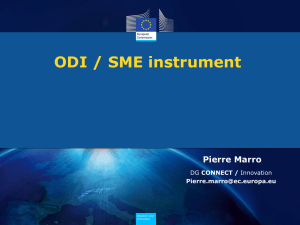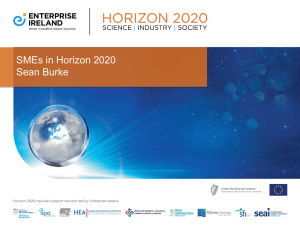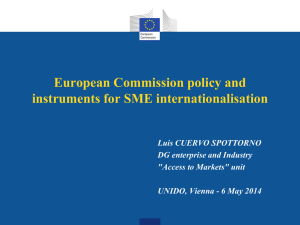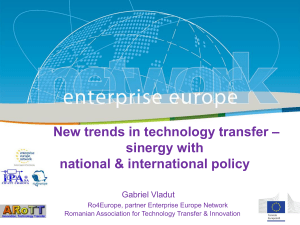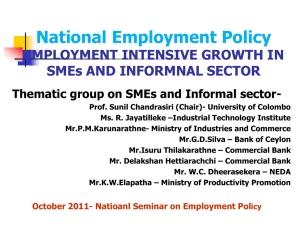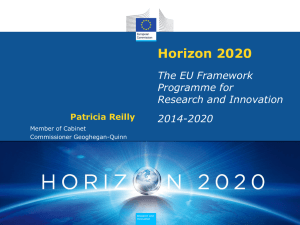Phase 2
advertisement
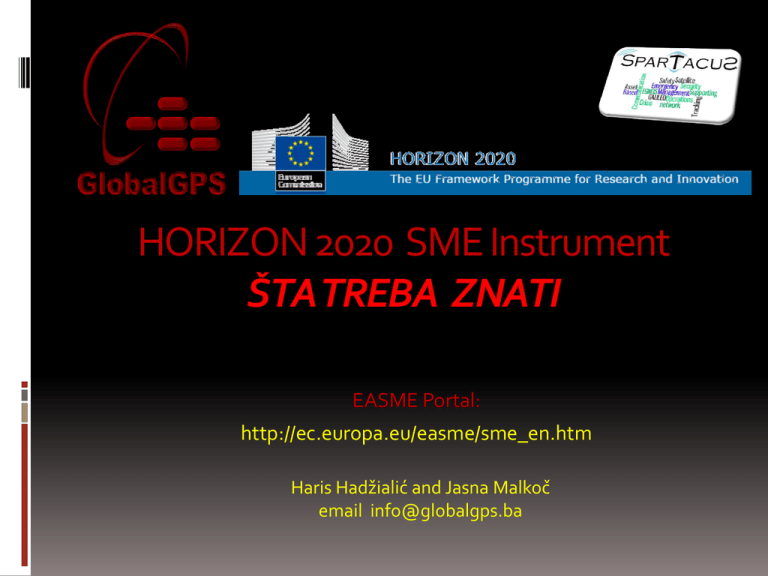
HORIZON 2020 SME Instrument ŠTATREBA ZNATI EASME Portal: http://ec.europa.eu/easme/sme_en.htm Haris Hadžialić and Jasna Malkoč email info@globalgps.ba Najčešće postavljanja pitanja Who can apply? Only a single for-profit SME or a consortium of for-profit SMEs can apply for funding under the SME instrument. Other partners like research providers or larger companies can be involved as third parties, in general in a subcontracting relationship. Can I apply as single entity? If you are a for-profit SME, yes. For-profit SMEs’ means micro-, small- and medium-sized enterprises, as defined in Commission Recommendation 2003/361/EC, that are not 'non-profit legal entities' as defined in Article 2 of the Rules for Participation and Dissemination (‘legal entity which by its legal form is non-profit-making or which has a legal or statutory obligation not to distribute profits to its shareholders or individual members’).. Can SMEs from third countries participate? Only applications from a single SME or a consortium of SMEs, that are all established in EU Member States or countries associated to Horizon 2020 are eligible for funding. In principle, SMEs established in third countries could be involved as third parties, for example in a subcontracting relationship. Is there a limitation to participation of beneficiaries to a maximum number of applications/projects at any time regarding the SME instrument? The rule is: no concurrent submission or implementation with another phase 1 or phase 2 project, be it as lead (even single) applicant or partner in an SME consortium. In case the applicant or any of the members of the consortium would have submitted another application for SME instrument Phase 1 or Phase 2, it is not possible to submit a proposal until the moment an applicant receives the information that the submitted proposal will not be funded. If a proposal has been accepted for funding and for the duration of the project, it is also impossible to submit a proposal since it would be ineligible. Horizon 2020 as a single programme Horizon 2020 is a single programme combining The Frame Programme 7, the European Institute of Innovation and Technology (EIT) and the Competitiveness and Innovation Framework Programme (CIP). It is a one-stop shop for acquiring European project funding. Simplified set of financial rules The EU contribution is up to 100% of the total eligible costs for R&D projects and up to 70% for innovation projects. In all cases indirect costs will be covered by a flat rate of 25% of the direct costs. TARGET SHIFT PROMJENA ODREĐENJA from SCIENCE with SMEs towards SMEs with SCIENCE “SMEs in the driver seat” SCOPE SHIFT PROMJENA OBLIKA from TECHNOLOGY segmentation towards CHALLENGE oriented segmentation “Market driven, bottom-up” SYSTEM SHIFT PROMJENA SISTEMA from Specialised programme structures towards INTEGRATIVE architecture “Synergies of support measures” Horizon 2020 Societal Challenges Health, demographic change and well-being Food security, sustainable agriculture, marine and maritime research, and the bio-economy Secure, clean and efficient energy Smart, green and integrated transport Climate action, resource efficiency and raw materials Inclusive, innovative and secure societies EIT 31748 M€* Industrial Leadership Leadership in enabling and industrial technologies (LEITs) Access to risk finance Innovation in SMEs Excellent Science European Research Council (ERC) Future and Emerging Technologies (FET) Marie Curie Actions Research infrastructure 24598 M€* 17938 M€* Strategic positioning Horizon 2020 Collaborative Research Target: R&D topics R&D driven projects Eurostars Target: R&D intensive SME Horizon 2020 SME instrument Target: Business innovation motivated SMEs Market opportunity driven projects Coaching and EEN support Phase 1 Phase 2 Phase 3 Regional EEN Initial Assessment HR … Facilitation and Moderation SME Instrument Coaching (not part of EEN) Support for Application Support for EU project Management Support for Access to Finance 12 HORIZON 2020 Fast track to Innovation Topic Under the Fast Track to Innovation (FTI) pilot, proposals for innovation actions linked to any technology field are covered, on the basis of a continuously open call (with its first cut-off date in 2015) and a bottomup-driven logic. FTI allows small innovative projects to be funded at any time. Collaborative projects Collaborative projects are a major part and the core activity of European research funding. Research and development in Public Private Partnerships is promoted. Projects are carried out by consortia with participants from different countries and with different activity types, such as higher education institutions, research centres and industry, including SMEs. A number of topics have a special focus on SMEs by setting apart a major part of the budget for R&D activities for SMEs. The size, scope and internal organisation of projects are defined in the various Work Programmes. HORIZON 2020 Eurostars Research-intensive SMEs are addressed by Eurostars 2, the follow-up of the successful Eurostars programme. Eurostars aims to support R&D performing SMEs by co- financing marketoriented innovation activities with a bottom-up approach. The budget of the programme will be significantly higher than its predecessor. With streamlined and improved procedures, Eurostars 2 will promote technological progress and business development, whilst boosting employment and export for European small businesses. Access to risk finance Access to risk finance aims to leverage private Research & Innovation investments, including venture capital investments for innovative, high-tech companies - in particular SMEs. Horizon 2020 allocates a budget of € 2.84 billion for financial instrument facilities and accompanying measures for Research & Innovation. At least one-third of this amount is likely to be dedicated to SMEs and small mid-caps. Two financing facilities will be available: A debt facility providing loans, guarantees and other forms of debt finance to entities of all forms and sizes, including research and innovation-driven SMEs; An equity facility providing finance for early-stage and growth-stage investments, with a particular focus on early-stage SMEs with the potential to carry out innovation and grow rapidly. Access to risk finance is implemented via the European Investment Bank and the European Investment Fund and/or other financial institutions of comparable stature. The organisation of a mentoring scheme Network of innovation Agencies Investors Networks (e.g. EBAN, EVCA) (e.g. TAFTIE) Industry Sector Platforms Specialist support for SMEs Coaching/ (Associations, Mentoring Networks Clusters) Coaching «strategic innovation» Central EC management Coaching «financing» (e.g. Exec. Agency) Coaching «technological innovation» EEN SME/ Start-up Horizon 2020 Idea/Concept = Business plan I Phase 1: Concept and feasibility assessment Input: Idea/Concept: "Business Plan 1" (~ 10 pages) 10% budget Feasibility of concept Risk assessment IP regime Partner search Design study Pilot application intention Business plan II Phase 2: R&D, demonstration, market replication Input: "Business plan 2" plus description of activities under Phase 2 (~ 30 pages) 88% budget Development, prototyping, testing Piloting innovative processes, products and services Miniaturisation/design of products Planning & developing scaling-up (market segments, process etc.) Market replication 10% success 30-50% success Business plan III Lump sum: around 50.000 € Cost reimbursement: 0.5 to 2.5 M€ EC funding ~ 6 months 12 to 24 months Phase 3+coaching 2% budget Phase 3: Commercialisation Quality label for successful projects Facilitate access to private finance Support via networking , training, coaching, information, addressing i.a. IP management, knowledge sharing, dissemination SME window in the EU financial facilities (debt facility and equity facility) No direct funding Demand Based on various surveys (EVCA, EIM, NESTA), it is estimated that about 1% to 6 % of all SMEs belong to the target group, i.e. 200,000 to 1.2 million SMEs. Without restrictions it is estimated to receive 10,000 to 15,000 SME applications for Phase 1 every year. This number is limited in case of topic oriented calls Measures to "reduce" applications: 1. Only one application per company (in both phases) 2. This implies: no possibility to apply for Phase 1 during the submission and/or implementation of a Phase 2 project and vice versa. 3. Advice by the support network(s) 4. SMEs should be encouraged to enter the scheme in Phase 1 Volumes and funding (overall~2,8 B€over 2014-2020) 5,200 Phase 1 projects 2% coaching 10% 50 k€ lump sum 23 miliona SME je baza iz koje svake godine konkuriše minimalno 48000 firmi za grantove 1,700 Phase 88% Phase 3 projects 2 projects* Access to risk finance 0,5 to 2,5 M€ Phase 1 Phase 2 Phase 3 *Average size of 1.5 M€ Or 2550 projects of 1 M€, 1250 of 2 M€… Main features • Targeted at all types of innovative SMEs showing a strong ambition to develop, grow and internationalise (EU dimension) • Combination of demonstration and market replication encouraging the involvement of end users/potential clients, research as appropriate • Only SMEs allowed to apply for funding • Single company support possible 20 Main features (2) • Simple rules and procedures • Continuous open call with 3-4 cut-off dates per year • No obligation for applicants to sequentially cover all three phases; Each phase open to all SMEs; however SME strongly encouraged to go in phase1 • Bottom-up approach, each SC & LEIT themes defines a broad topic • Central implementation through Executive Agency Evaluation 1. Remote evaluation whole process 2. Suggestion to abandon consensus meetings 3. Long feedback loops ("ESRs") slow down the process 4. Evaluation criteria focus : a) Excellence b) Impact c) Quality and efficiency of the implementation 5. Competences of evaluators is important Award Criteria - DRAFT Excellence: Impact: • Soundness of the concept, including transdisciplinary considerations; • Enhancing innovation capacity and integration of new knowledge; • Progress beyond the state of the art. Quality of the implementation: • Competences, experience and complementarity of • Strengthening the the individual competitiveness and growth of participants, as well companies by developing as of the consortium innovations meeting the needs as a whole; of European and global markets; • Appropriateness of • Effectiveness of the proposed the management measures to communicate the structures and project, disseminate and/or procedures, exploit the project results, and including risk appropriate management of IPR. management. Nacrt tema Area LEIT ICT Topics &Budget Open Disruptive Innovation Scheme; 45 M€ per year, Estimated projects per year: 90 phase 1, 26 phase 2 LEIT Nanotechnology Accelerating the uptake of nanotechnologies, advanced materials or advanced LEIT Advanced manufacturing and processing technologies by SMEs materials 21.8 M€ (2014), 23.8 M€ (2015) &processing Estimated projects: 43 phase 1 , 13 phase 2 (2014) LEIT Advanced Estimated projects: 47 phase 1, 14 phase 2 (2015) manufacturing LEIT Biotech SME boosting biotechnology-based industrial processes driving competitiveness and sustainability; 3.80 M€ (2014), 2.40 M€ (2015) Estimated projects: 7 phase 1, 3 phase 2 (2014) Estimated projects: 5 phase 1, 1 phase 2 (2015) LEIT Space SME innovation in space applications, 8.5 M€ (2014), 8.75 M€ (2015) Estimated projects: 17 phase 1, 5 phase 2 (2014) Estimated projects: 18 phase 1, 5 phase 2 (2015) Nacrt tema Area SC2 Bio-economy SC3 Energy SC4 Transport SC5 Climate Topics &Budget Resource-efficient eco-innovative food production and processing 9 M€ (2014), 17 M€ (2015) Estimated projects: 18 phase 1, 5 phase 2 (2014) Estimated projects: 34 phase 1, 10 phase 2 (2015) Supporting SMEs efforts for the development - deployment and market replication of innovative solutions for blue growth 6.8 M€ (2014), 7.4 M€ (2015) Estimated projects: 13 phase 1, 4 phase 2 (2014) Estimated projects: 15 phase 1, 4 phase 2 (2015) Stimulating the innovation potential of SMEs in a low carbon and efficient energy system 33.95 M€ (2014), 37.26 M€ (2015) Estimated projects: 67 phase 1, 20 phase 2 (2014) Estimated projects: 74 phase 1, 22 phase 2 (2015 Small business innovation research for Transport 35.87 M€ (2014), 38.96 M€ (2015) Estimated projects: 72 phase 1, 21 phase 2 (2014) Estimated projects: 78 phase 1, 23 phase 2 (2015) Boosting the potential of small businesses for eco-innovation and a sustainable supply of raw materials; 17M€ (2014), 19 M€ (2015) Estimated projects: 34 phase 1, 10 phase 2 (2014) Estimated projects: 38 phase 1, 11 phase 2 (2015) Nacrt tema Area SC6 IIIS Topics &Budget no topic in 2014 Innovative mobile e-government applications by SMEs, 4M€ (2015) Estimated projects: 8 phase 1, 2 phase 2 SME business model innovation, 11 M€ (2015) Estimated projects: 22 phase 1, 6 phase 2 SC7 Security Protection of urban soft targets and urban critical infrastructures 7 M€ (2014), 7.4 M€ (2015) Estimated projects: 14 phase 1, 4 phase 2 (2014) Estimated projects: 15 phase 1, 4 phase 2 (2015) Total 254.82 M€ (2014) 266.97 M€ (2015) Raspored dešavanja - preliminarno Phase 1 2014 Phase 2 Phase 1 2015 Phase 2 18/06/2014 09/10/2014 18/03/2015 18/03/2015 24/09/2014 17/12/2014 17/06/2015 17/06/2015 17/09/2015 17/09/2015 16/12/2015 16/12/2015 17/12/2014


